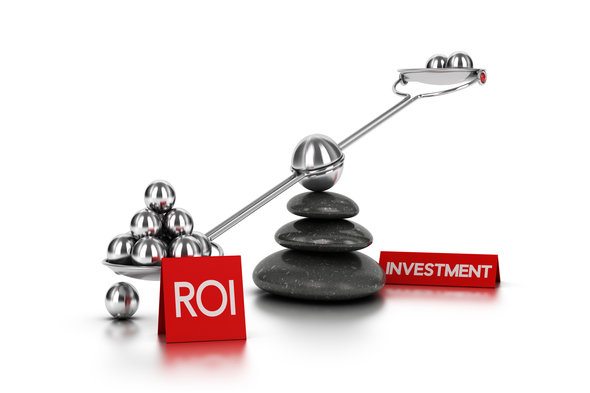
One of the most important considerations when evaluating your portfolio is figuring out what the return on investment (ROI) is for all the investing choices you make. Return on investment is a ratio that represents your earnings in comparison to the costs of your investment. This number can gauge the bottom line return of an investment, whether it’s in real estate, stocks or bonds. After you get a grasp on what is ROI, learn how it can help with not just investment evaluation, but also with investment and retirement planning.
Check out SmartAsset’s financial advisor matching tool.
What Is ROI?
ROI, or return on investment, is a ratio that represents your earnings in comparison to the costs of your investment. It is a common way to describe an investment’s profitability.
The business world uses the term to quantify all sorts of returns, from operational to marketing to equity. Investors of all kinds also use it. ROI is a helpful measurement since it can be applied broadly to all of your investments and used to compare their profitability. The higher your return, the better your investment.
How to Calculate ROI

You can calculate ROI on a particular investment by dividing your net profit by your initial cost and multiplying by 100. So, if you bought 50 shares of a stock at $20 per share, you invested $1,000. Then, later you sell your 50 shares for $25 per share, earning $1,250. Your ROI is (1250-1000)/1000 = 0.25 or 25%.
The calculation gets a bit more complicated if your investment pays out dividends or charges fees. Dividends are when a company shares profits with its stockholders, and is often expressed as a certain percent per share. Dividends count as gains on your investment.
If a financial advisor professionally manages your portfolio, you will probably have to pay fees out of your profits, either as a percentage or a flat fee. Even if you don’t have a manager, you may have paid trading fees when buying or selling your stocks. Whatever your fees are, subtract them from your gains before calculating ROI.
How to Use ROI to Evaluate Your Investments
One of the reasons that ROI is such a commonly used figure is that it can be calculated for all kinds of investments. This enables investors to compare the profitability of all of their investments using the same scale.
Regardless of your asset allocation, you can calculate each investment’s return with this simple formula. This way, you can evaluate which of your investments are doing well and which are not. Then, you can use the data to consider making changes to your portfolio.
Adding Time to the Equation: Annualized Rate of Return
One of the things to remember about ROI is that it doesn’t take time into account. So whether you sell your stocks in the example above for $250 profit after one year or after five years, the ROI is still 25%. But, of course, a return of 25% over one year is more impressive than a return of 25% over five years.
To calculate the annualized rate of return, or annual percentage yield (APY), you have to use the decimal version of your ROI (what you have before multiplying by 100), and add 1. Determine how many years you have had the investment, then divide 1 by that number. Take the result and find your ROI to the power of that number, then subtract 1.
The formula written out is (ROI+1) ^ (1/years held) – 1 = Annualized Rate of Return.
As an example, let’s calculate the APY for a 25% ROI over one year and over five years.
For one year: (0.25+1) ^ (1/1) -1 = 1.25^1-1 = 1.25-1 = 0.25 = 25%
As expected, the return over one year and the overall return are both 25%
For five years: (0.25+1) ^ (1/5) -1 = 1.25^0.2-1 = 1.046-1 = 0.046 = 4.6%
If you earn 25% over five years, the return is much less impressive: an annual average return of just 4.6%.
This is why, while ROI is an important metric, it is not necessarily the best way to determine your investments’ profitability.
ROI for Investment and Retirement Planning
ROI is a useful tool not just for your current investments, but also for investment planning. When researching securities, you should be able to see their past performance. By calculating the average ROI, you will be able to compare your potential investments. This gives you more data with which to decide where to invest.
Whether with new or current investments, you can use the past and present ROI to extrapolate future earnings. Once you know how an investment has been performing, you can use its standard rate of return to estimate its future performance. If you are making investments to save for retirement, use these calculations to estimate your portfolio’s growth over time. You’ll be able to see when you should have enough money saved up to retire comfortably. Be careful, however, as future earnings are not guaranteed simply based on past performance.
The Bottom Line

ROI is a simple ratio to determine the profitability of an investment. The calculation shows how much you’ve made on an investment compared to how much you put in. Using ROI, you can analyze all of your investments on the same scale, making it easy to compare profitability. You can also extrapolate on an investment’s future profits, which can be helpful when it comes to investment and retirement planning. Keep in mind that ROI does not take time into account. If you want to figure out how profitable an investment is by year, you have to calculate the annualized rate of return.
Investing Tips for Beginners
- Beginners can benefit from talking to a financial advisor. Finding the right financial advisor that fits your needs doesn’t have to be hard. SmartAsset’s free tool matches you with financial advisors in your area in 5 minutes. If you’re ready to be matched with local advisors that will help you achieve your financial goals, get started now.
- Minimize expenses. As mentioned above, you’ll see any fees you pay, whether for a financial advisor or for trades, subtracted from your gains before you calculate ROI.
- Diversify. Make sure you’re not putting all your eggs in one basket when you invest.
Photo credit: ©iStock.com/olm26250, ©iStock.com/PhotoBylove, ©iStock.com/nito100